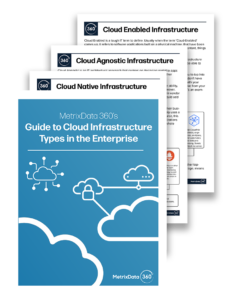On your way to the Cloud, you may be confronted with a lot of confusing terms while deciding on how to build your Cloud architecture. Terms like Cloud Native, Cloud Agnostic, and Cloud Enabled are often used seemingly at random.
At MetrixData 360, we have helped many of our clients successfully migrate to the cloud and we want to ensure your migration to the Cloud is successful as well.
We’re going to break down the difference between the three terms and what advantages and disadvantages each of these solutions can bring to your Cloud platform.
But, before you dive head first into the complex definitions of cloud infrastructure, we suggest you watch this video to get warmed up:
Cloud Native
Definition: What is Cloud Native?
Cloud Native is a bit of a loose term that can generally be described as the action of building and running applications that exploit the advantages of the cloud delivery model. Kind of vague, isn’t it? When you sign up for Cloud Native architecture, it’s typically only a matter of selecting a Cloud Provider and building your architecture to stick with that provider exclusively. Cloud Native architecture relies heavily on services tied to the Cloud Provider themselves, such as Azure Monitoring services in Azure or CloudWatch in AWS.
Companies go about establishing Cloud Native platforms by utilizing vendor-specific offerings like AWS’ function-as-a-service and Azure’s globally-distributed database Cosmos DB.
The Pros of Cloud Native
- Going Cloud Native will make it much easier to create resilient cloud architecture
- Cloud Native solutions often come with better performance, and better efficiency
- Easily scalable and some Cloud providers offer features for load balancing like Amazon and Google.
- Often the cheapest option, since you will be licensed based on use and storage needs and there are no software/hardware installations needed.
- Easily maintained
- While it is typical for architecture to be built to be platform-specific, applications can still be moved between infrastructures if necessary.
The Cons of Cloud Native
- Services like AWS’s function-as-a-service and Azure’s Cosmos DB make you locked in with that specific vendor and makes it quite difficult to move to a different provider.
- You will have to use native APIs, which will involve a lot of code rewriting if you ever move to a different Cloud provider
Download Our Cloud Infrastructure Guide Today
See how enterprises across the globe configure cloud-native, enabled, and agnostic workload infrastructures to keep up with today’s volatile market.
Cloud Native vs. Cloud Enabled Applications
As if the Cloud couldn’t be more confusing, ‘Cloud Native’ is actually a two-fold term which also may be used when referring to applications.
Not to be mistaken with Cloud Enabled applications, Cloud Native applications are ones that are built exclusively for the Cloud; they were born in the Cloud and are deployed and work best in the Cloud. It is expected that Cloud Native applications will become the norm as time progresses, with 90% of all new apps using Cloud Native structures and an estimated 35% of all production apps being Cloud Native by 2022.
Cloud Native Solutions are often viewed as the more attractive option since they better harness the full advantages of life in the clouds, they are designed to host multi-tenant instances and they are usually significantly cheaper than Cloud Enabled applications.
While Cloud Native and Cloud Enabled might be used interchangeably at times, they are not always discussing the exact same thing.
Cloud Enabled applications are applications which have been originally made for and in a static environment on-prem and are meant to reside on an in-house server or data center. This piece of legacy enterprise software is then simply tweaked and restructured to be enabled in the Cloud in order to offer its customer’s remotely available and easy management. While they may be similar to their Cloud native counterparts, using a Cloud Enabled application will leave you with limitations on how that application can interact with the full cloud environment, creating issues such as:
- Slower implementation as a result of server configuration, customization, and software/hardware set up.
- Not easily scalable and requires manual upgrades
- Tends to be the more expensive of the three options
Vendors who offer Cloud Enabled applications might try to pass them off as Cloud Native, since Cloud Native solutions are the far more popular option on the market and are considered to be a short-hand for ‘modern applications and infrastructure practices.’
Cloud Agnostic
Definition: What Is Cloud Agnostic?
Being Cloud Agnostic means building your architecture to utilize everything open source technologies and portable components have to offer, this architecture is built to be able to switch providers easily, or even allow for the use of multiple cloud providers simultaneously. Unlike Cloud Native solutions, where you will typically be at the mercy of your Cloud solution provider, Cloud Agnostic gives you the freedom to forge your own path into the clouds.
The Pros of Cloud Agnostic
- It will be relatively easy to migrate from one cloud provider to another, in some cases it will just be a matter of exporting your data from one platform to another. This is one of the main reasons why a company might switch from a Cloud Native solution to an Agnostic one.
- You can expect consistency of performance when moving between platforms
- Allows for easy migration of on-prem applications
- You are able to maximize redundancies
The Cons of Cloud Agnostic
- Often more expensive than Cloud Native architecture (but not always, sources vary)
- More difficult to build highly available architecture without using a Cloud Native solution
- If you are hopping between vendors, you may not have the ability to take full advantage of the capabilities of a single vendor.
- You will be responsible for monitoring multiple platforms at once
Getting Help for Your Migration to the Cloud
The Cloud can be a turbulent place, with so many options and muddled terms that it might be easier to stay rooted to your on-prem solution.
Software infrastructures are unique for every company, there’s no one way to do it and the same is true when it comes to building your company’s platform in the Cloud. When deciding what your Cloud platform will look like, it’s important that you know what your options are so you aren’t limited to a solution that might not be best suited your company’s objectives, goals, and budget.
At Metrixdata 360, we understand this complexity and companies desires to pick their own customizable solution, something that we prioritize when helping our clients in their transition. You stay in the driver’s seat and we ensure that your solution is as cost-effective as possible. Together, we’ll get you to where you want to be!
If you’d like to learn more about how we can help you smoothly transition into the cloud, then you can check out our Cloud Page.




